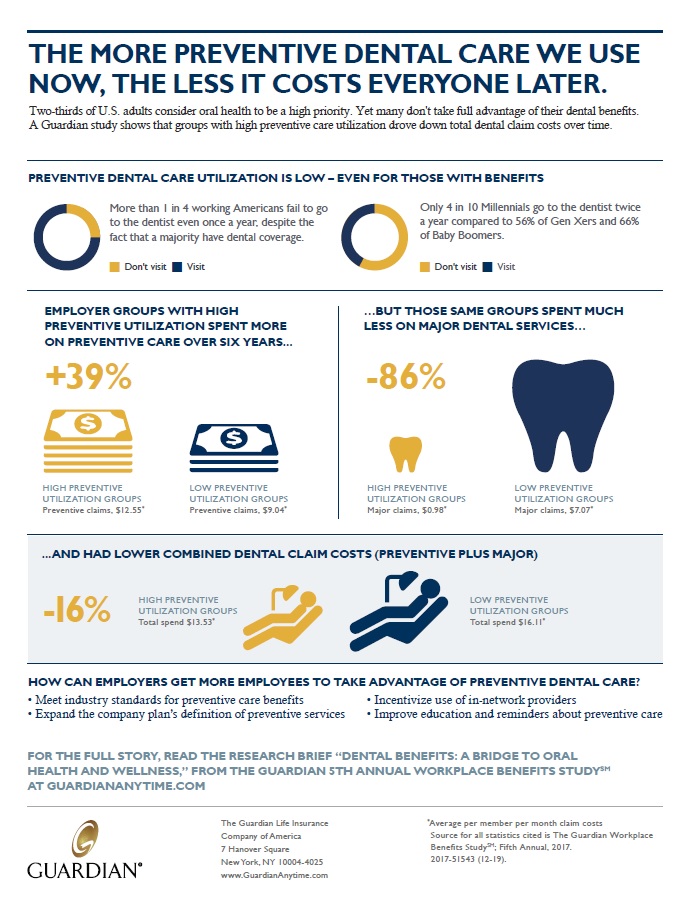It’s not just employees who do better when they take advantageof preventive dental care, warding off expensivetreatments down the road and cutting their out-of-pocket costs. But employers make out,too, saving money on group policies.
|That’s according to a new study from the Guardian Life InsuranceCompany of America, which finds that companies that proactivelyurge employees to use those preventive dental benefits can cut thecosts on group policies for workers.
|The fifth annual Guardian Workplace Benefits Study, Dental Benefits: A Bridge to Oral Health & Wellness,analyzed dental claims data from 2011–2017. It categorized employergroups based on the utilization of preventive and major serviceswithin their companies; groups were tagged as eitherhigh-preventive-utilization or low-preventive-utilization.
|The study found that the high preventive-utilization employergroup spent 39 percent more on preventive care over a six-yearperiod, but 86 percent less on major and restorative dentalservices. That ended up translating to costs that were 16 percentlower on preventive and major dental claims costs than wereincurred by the low preventive-utilization employer group.
|Not only that, but seeing a dentist regularly can, according tothe Academy of General Dentistry, help with early detection ofpotentially serious medical conditions, especially since more than90 percent of all systemic diseases produce oral signs andsymptoms.
|Dr. Randi Tillman, chief dental officer at Guardian, is quotedin the report saying, "Good oral health is linked to positiveoverall health and self-esteem. Regular dental visits can help withcertain health needs including managing diabetes, lowering heartdisease risk, and contributing to a healthy pregnancy.”
|With millennials among the least likely to go to the dentisttwice a year, the study finds more than one in four adults fail togo at least once a year. Millennials have lots of reasons toprocrastinate, too, with cost chief among them. Forty percent ofadults have stalled recommended procedures or skipped exams, x-raysand tests in the past year thanks to higher out-of-pocket costs.Doing so, however, will cost them in the long run, with higherout-of-pocket expenses to cover restorative procedures.
|
So how can employers boost dental usage among employees (andthus drive their own costs down)? The study suggests they meetindustry standards for preventive care benefits; expand theirplan’s definition of preventive services; incentivize the use ofin-network providers; and enhance plan member communication.
Complete your profile to continue reading and get FREE access to BenefitsPRO, part of your ALM digital membership.
Your access to unlimited BenefitsPRO content isn’t changing.
Once you are an ALM digital member, you’ll receive:
- Critical BenefitsPRO information including cutting edge post-reform success strategies, access to educational webcasts and videos, resources from industry leaders, and informative Newsletters.
- Exclusive discounts on ALM, BenefitsPRO magazine and BenefitsPRO.com events
- Access to other award-winning ALM websites including ThinkAdvisor.com and Law.com
Already have an account? Sign In
© 2024 ALM Global, LLC, All Rights Reserved. Request academic re-use from www.copyright.com. All other uses, submit a request to [email protected]. For more information visit Asset & Logo Licensing.








